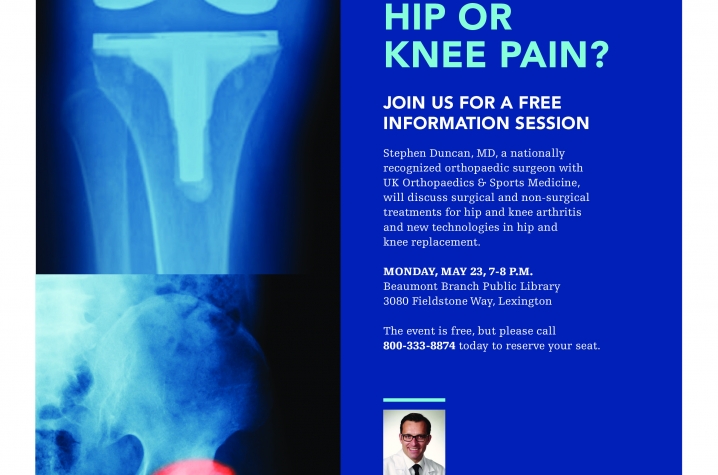Know the Signs to Preventing and Treating Joint Pain
LEXINGTON, Ky. (May 23, 2016) – In the past four weeks, more than one-third of people over the age of 55 in the United States have complained about hip or knee pain to their physician. In a lifetime, our hips and knees get a lot of use. There are various ways individuals can reduce the strain placed on their joints to maintain the health of their hips and knees.
Preventing Knee and Hip Pain
Individuals have some ability to reduce the strain put on their knees and hips. The relationship between being overweight and joint pain is a contentious one. If joint pain is rooted in being overweight, it is important to healthily lose weight. Developing a stronger core can also lessen the strain placed on joints.
People who engage in "high impact" activities, like running, basketball or Zumba, can take steps to prevent joint issues like torn ligaments and inflammation. Physical therapy, to strengthen the muscles surrounding the hips and knees, can do wonders in reducing and preventing joint pain.
Supplements can aid in improving joint health and reducing pain. Omega 3s block inflammatory cytokines and prostaglandins, reducing joint tenderness and stiffness. Also, ginger has been shown to be a natural anti-inflammatory while Capsaicin reduces substance P, a pain transmitter.
Treatment Options
In the United States, nearly 30 million people are treated for joint pain in their knees and hips each year. Too often, joint pain is considered part of aging, and if a person has suffered over a long period of time, it can be considered part of life. Persistent joint pain, which lasts more than six months and is not responding to activity modification and/or anti-inflammatory medicines, means it's time to see an orthopedist.
Common treatments for knee and hip joint pain are arthroscopy and joint replacement. Arthroscopy can be done for patients with mild arthritis to remove a torn meniscus in the knee or a labrum in the hip. Recovery from this procedure is typically four to eight weeks. Hip or knee replacements are done for more advanced arthritis. Recovery for hip replacement is typically four to eight weeks, but is largely dependent on the patient's health. Partial knee replacement recovery lasts approximately four to six weeks; a total knee replacement has a recovery time of six to 12 weeks.
Reducing the chances of needing orthopedic surgery is possible, but knowing the signs of pain that may require medical intervention is vital.
Dr. Stephen Duncan is assistant professor of orthopaedic surgery in the University of Kentucky Department of Orthopaedic Surgery and Sports Medicine.
MEDIA CONTACT: Olivia McCoy, olivia.mccoy1@uky.edu, (859) 257-1076
###
UK is the University for Kentucky. At UK, we are educating more students, treating more patients with complex illnesses and conducting more research and service than at any time in our 150-year history. To read more about the UK story and how you can support continued investment in your university and the Commonwealth, visit uky.edu/uk4ky. #uky4ky #seeblue






